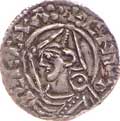Cnut was the son of Sweyn Haroldson, king of Denmark, who briefly seized the English crown (1013) after a series of Viking raids, which he successfully led. Cnut was in charge of the Danish fleet when Sweyn died suddenly on 3 Feb 1014. The fleet proclaimed Cnut king, but he could not accede to the throne and gave way to the exiled King Æthelred Unræd, who returned to England in the spring of 1014. Cnut sailed for Denmark, where he prepared a military expedition to regain the English crown. Landing in Wessex in the summer of 1015, Cnut laid siege to London in April 1016. When King Æthelred died on 23 Apr 1016, the citizens of London and a part of Witan members chose his son, Eadmund, as king, but the other members meeting at Southampton elected Cnut. After the English troops were utterly defeated in the Battle of Ashingdon (18 Oct 1016), Eadmund accepted a peace settlement on the Isle of Olney and divided the kingdom with Cnut, who received all of the country north of the Thames. When Eadmund died on 30 Nov 1016, Cnut was accepted as king of 'all the kingdom of England'. Cnut began his reign with exterminating Anglo-Saxon nobles and dividing the country into four districts ruled by military governors. In 1017 Cnut married Æthelred's widow, Emma of Normandy, though he also kept his mistress, Ælfgifu, who bore him two sons, Harold and Sweyn. Two years later, Cnut left England to secure his succession in Denmark after the death of his brother, Harald (1018). Thorkell the Tall acted as regent during Cnut's absence from 1019 to 1020. Cnut was again in Denmark in 1025 and his fleet was driven away in a battle at Holy River in southern Sweden in 1026. Then he went on his pilgrimage to Rome (1027), where he visited Pope John XIX and attended the coronation of Emperor Conrad II (26 Mar 1027). Cnut invaded Norway in 1028 and forced King Olaf II Haraldsson to flee. Cnut summoned an assembly of nobles at Trondheim, Norway, and proclaimed his son, Harthacnut, as king of Denmark. Earl Hakon Eriksson was made a governor of Norway, but he drowned in 1030 and Cnut appointed his other son, Sweyn, as king of Norway (1035). Cnut came back to England in 1029 and made a second visit to Rome in 1031. Upon his next return to England, Cnut mounted an expedition to Scotland (1031) and subdued King Malcolm. The conquest of the Danes made Cnut a ruler of a vast northern empire, which included Denmark, England, Norway and parts of Sweden. Although Cnut spent most of his life in warfare, England enjoyed peace and prosperity under his rule. Cnut introduced the laws drafted into a legal code by Archbishop Wulfstan, which were mainly based on previous legislation of King Eadgar. English trade profited by Cnut's control of the Baltic trade route. Cnut was accepted as a real power in the 11th century Europe and was respected by both emperor and pope. As evident from a few existent charters, Cnut spent the last years of his reign in England. Cnut was less than forty years old when he died at Shaftsbury, Dorset, on 12 Nov 1035. Biography sources: [1][2][3][4] |

